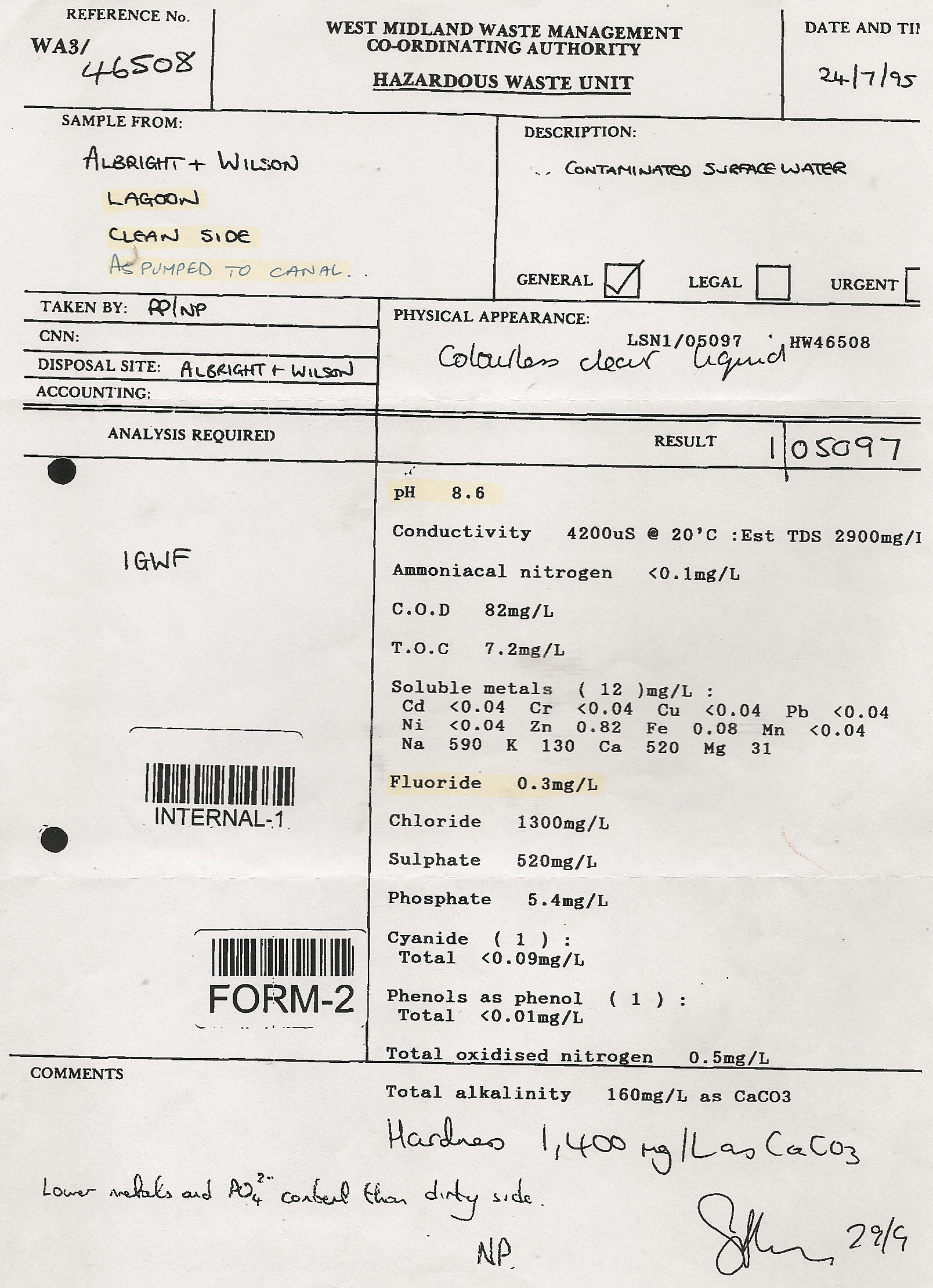Discharge consents into Birmingham Canal Mainline from Rattlechain lagoon
BACKGROUND
In order to maintain the levels of the lagoons, “water” is allowed to be discharged into the Mainline Birmingham Canal system.
Originally The National Rivers Authority gave consent to do this which was numbered T/8/22375/T WQ/7/477, which was subsequently varied to number WQ/7/477V given to Albright and Wilson Limited on 19th December 1977 and 20th February 1981 by The Severn Trent Water Authority.
Subsequently consent number T/6/22375/T was modified by the NRA in respect of the making of a discharge subject to conditions set out in a schedule. The National Rivers Authority was superceeded by The Environment Agency by virtue of The Environment Act 1995.
A number of consent limits were provided under these consents, which also applied to other sites controlled by Albright and Wilson/Rhodia shown in the following table.
Monitoring of these consent levels were carried out by the West Midland hazardous waste unit, which then transfered to The Environment agency in 1996. An example of such a form from 1995 is shown below. N.B they refer to the “clean side” of the lagoon meaning the smaller subsidiary western lagoon.
WHAT DID WE ASK?
1. Could you firstly confirm that you are the statutory successor as
“the authority” to the National Rivers Authority?
2“Can you confirm if there were any subsequent modifications made AFTER the one made by the NRA after 6th May 1993 and list the numbers for these consents?”
3 We also asked if these had been transferred to Rhodia.
4 Can you confirm what limits either Severn Trent, The NRA or the Environment Agency set for white phosphorus in the effluent consent limits, or if this particular chemical was tested for in either the works effluent or into the canal system from the Ratlechain
landfill owned by Albright and Wilson? By white phosphorus I mean elemental phosphorus P4 and not “phosphorus” as P.
5. Can you confirm what capabilities the Environment Agency have today for testing for white phosphorus in analysis of effluents/water or other matter, and whether any of their laboratories have an accredited method for doing so?”
WHAT DID THEY KNOW?
The agency initially responded by answering the first 4 questions.
1. We are the statutory successor by virtue of the Environment Act 1995.
2 & 3. Please find attached copy of the Discharge Consent T/08/22375/T, previous number WQ/7/477 and variation. There has been no modifications since 6 May 1993.
The consent was transferred on three occasions as follows:
Rhodia Consumer Specialities Ltd – transferred 14 March 2000
Rhodia Consumer Specialties Ltd – transferred 27 June 2001
Rhodia UK Ltd – transferred 01 January 2005.
4. There is nothing in the consent that sets limits for elemental phosphorus
The remainder of the information you have asked for is still being collated.”
This was eventually provided after some delay.
4. There is nothing in the consent that sets limits for elemental phosphorus P4
“ The consent we supplied to you does not set limits for elemental phosphorus P4. The same is true for Environmental Permit Number EPR/SP3339BL that is in force for the Oldbury Chemical Works. Table S3.2 on page 26 of the permit requires the site to analyse spot samples of the storm overflow to the adjacent canal for phosphorus. This is total phosphorus as P not elemental phosphorus P4.
Please find attached a copy of the permit .for your convenience
As neither the consent nor the permit sets limits for elemental phosphorus P4, it is unlikely that we have asked for this to be tested in either of the discharges mentioned above. If the company have analysed for P4, it will have been for their own internal purposes because it is not a reportable requirement under either of our permits.
5 In response to “Can you confirm what capabilities the Environment Agency have today for testing for white phosphorus in analysis of effluents/water or other matter, and whether any of their laboratories have an accredited method for doing so?”
Because we and our predecessor organisations have not requested an analysis of elemental phosphorus P4, our National Laboratory Service does not have an accredited method for it’s’ analysis in any medium. If we were to request such an analysis now, they would sub-contract the work to another laboratory suitably accredited for this determinand rather than spend time developing their own capability and purchasing the instruments needed. This would be reviewed if there was sufficient demand to make the development of the capability cost effective.”
WHAT DOES THIS MEAN
The supplied information confirms that the discharge to canal was described as “trade effluent consisting of pumped quarry water from the company’s Rattlechain Tip site.”
Consent limits for arsenic, cadmium, chromium, copper, lead,nickel and zinc were set.
For toxic elemental white phosphorus they were not.
Concern regarding how white phosphorus release may be occurring from the site undetected by the pollution permitting regime is confirmed in this request to the Environment agency, concerning the discharge consent that the company have to the Birmingham canal mainline. This would ultimately have to be the route which excess water is pumped out of the lagoon. In light of information which we had obtained that the subsidiary “clean side” lagoon was in fact constructed out of an original contaminated single pool, it has subsequently been confirmed that this pool does indeed contain white phosphorus, and yet water from this side has been pumped into the canal for several decades- but what monitoring has ever taken place and what evidence is there that this has not led to potential human health problems let alone environmental ones?
It has subsequently been revealed in Rhodia’s HSE Landfill site management procedures that the discharge consent has now been transfered to the phoenix company “Rhodia Ltd”.




